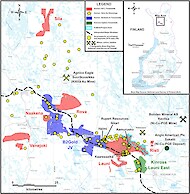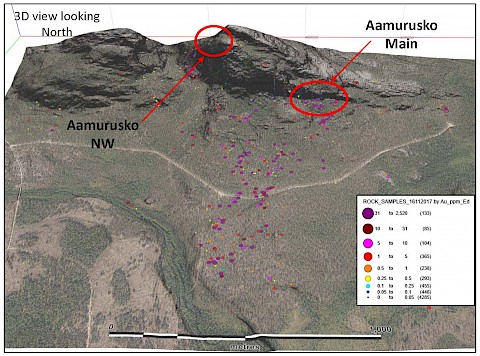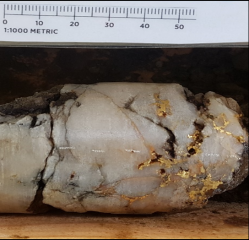Risti
Maps

Latest News
- Dec 2, 2025 - Aurion Reports the First Results from the Autumn Drill Program at Kaaresselkä, Risti property
- Sep 8, 2025 - Aurion Extends the Strike of the Mineralized System by 300 m to 1.4 km at Kaaresselkä, Risti Property
- Aug 11, 2025 - Aurion Intersects 4.42 g/t Au over 32.55 m at Kaaresselkä, Risti Property
Overview
Property and Location
The Risti Project covers approximately 170 km2 in the Central Lapland Greenstone Belt (“CLGB”) in northern Finland. The centre of the Risti Project is located 20 km NW of Sodankylä, Finland, which is a 30-minute drive along paved and all-weather gravel roads through rolling hills and forests.
Geologic setting
The Paleoproterozoic Central Lapland Greenstone Belt shares many similarities to prolific gold and base metal rich orogenic greenstone belts globally, such as the Abitibi region of Northern Ontario, Canada.
Aamurusko Discovery
The Aamurusko high grade discovery is located at the center of the Risti property. Since 2016, more than 1,200 gold bearing quartz boulders with an average grade of 25 g/t Au have been sampled over an area of 1.3 km by 1.7 km. Aurion has identified at least two sources of the boulders via drilling and considers that the existence of other sources is plausible.
Gold mineralization at Aamurusko is mainly hosted by quartz veins within multiple rock types including clastic sedimentary rocks, gabbro and mafic volcanics. The gold mineralized system at Aamurusko is interpreted to extend over 1,000 m along strike and at least to 200 m depth. Mineralization remains open to further exploration both laterally and to depth.
Aamurusko Main drill highlights include:
- 789.06 g/t Au over 2.90 m from 116.10 m (Drill hole AM18042)
- including 3,510.00 g/t Au over 0.65 m
- 42.28 g/t Au over 4.00 m from 40.00 m (Drill hole AM19082)
- 24.50 g/t Au over 4.75 m from 48.80 m (Drill hole AM19081)
- 22.63 g/t Au over 3.53 m from 44.47 m (Drill hole AM19114)
- including 52.30 g/t Au over 1.4 m
- 18.47 g/t Au over 2.76 m from 43.94 m (Drill hole AM19113)
- including 93.70 g/t Au over 0.51 m
Aamurusko NW drill highlights include:
- 13.31 g/t Au over 19.54 m from 77.64 m (Drill hole AM19095)
- including 22.58 g/t Au over 8.18 m
- 3.51 g/t Au over 31.12 m from 55.88 m (Drill hole AM19094)
- 6.84 g/t Au over 19.00 m from 83.80 m (Drill hole AM19109)
- including 16.36 g/t Au over 7.30 m
- 23.41 g/t Au over 11.10 m from 133.00 m (Drill hole AM19106)
- including 51.95 g/t over 4.15 m
- 16.17 g/t Au over 4.00 m from 97.10 m (Drill hole AM19105)
- including 109.00 g/t Au over 0.58 m\
- 1.21 g/t Au over 24.75 m from 358.25 m (Drill hole AM20127)
- including 5.79 g/t Au over 2.95 m and 8.90 g/t Au over 1.00 m
Kaaresselkä Discovery
The Kaaresselkä prospect is located in the southern part of the Risti property, approximately 4 km south of Aamurusko.
The gold mineralized system at Vanha (part of the Kaaresselkä area) is interpreted to extend over 950 m along strike and to at least 200 m depth. The gold mineralization is open along strike and at depth. Scout drill holes, which intersected gold 1.8 km and 600 m to the west, as well as 600 m to the east of the Vanha prospect, highlight the potential for an extensive gold mineralized system in the Kaaresselkä area.
Kaaresselkä drill highlights include:
- 4.42 g/t Au over 32.55 m from 267.80 m down hole (KS25111)
- including 72.80 g/t over 1.00 m from 272.00 m
- 2.38 g/t Au over 56.55 m from 95.75 m down hole (KS22027)
- 7.92 g/t Au over 13.60 m from 162.10 m down hole (KS25097)
- including 57.60 g/t Au over 1.00 m from 168.35 m
- 31.90 g/t Au over 3.10 m from 20.10 m down hole (KS24079)
- 72.40 g/t Au over 0.85 m from 137.00 m down hole (KS23041)
- 8.08 g/t Au over 6.75 m from 186.95 m down hole (KS24091)
- 2.96 g/t Au over 16.25 m from 135.75 m down hole (KS24092)
- 3.63 g/t Au over 11.35 m from 94.55 m down hole (KS23071)
- 1.71 g/t Au over 22.00 m from 126.20 m down hole (KS25099)
- 8.11 g/t Au over 4.30 m from 59.00 m down hole (KS23043)
The gold mineralization is mainly hosted by highly deformed and altered (silica, sericite, albite) mafic volcanic and metasedimentary rocks with minor to moderate amounts of fine-grained sulphide minerals including pyrite, pyrrhotite, chalcopyrite, galena, sphalerite and arsenopyrite in varying quantities. The higher-grade intervals are mainly hosted within silicified and brecciated zones with a moderate amount of sulphides. Elevated levels of base metals, including copper, were encountered in several holes.
The geologic setting and the style of mineralization at Kaaresselkä resembles several recent and past discoveries such as Helmi (Aurion-B2Gold JV) and Ikkari (Rupert Resources) as well as the past producing Saattopora mine.
The gold-copper mineralization was discovered by the Geological Survey of Finland (GTK) in 1987 via geochemical and geophysical surveying, trenching and diamond drilling. Tertiary Minerals plc. (“Tertiary”) acquired the project by staking in 2003 and performed geochemical and geophysical surveys, and limited drilling in 2004 and 2005.
Aurion purchased 100% of Kaaresselkä from Tertiary in 2016. The Kaaresselkä property was subject to certain pre-production royalties and a 2% NSR (net smelter returns) royalty on production. Aurion had the option to buy back 50% of the NSR royalty for a cash payment of US$1 million at any time prior to commencement of commercial production.
In 2022, Aurion repurchased all royalties on Kaaresselkä and another property under JV with B2Gold (Kiekerömaa) for a total of CAD$200,000 and 83,333 Aurion common shares.
Other prospects
Numerous other areas of gold mineralization have been encountered within the Risti property including the Notches, YNOT and Tikka prospects among others.
In addition, elevated levels of copper, nickel and PGEs have been identified within the Risti property.
The drill results presented herein are core lengths and may not represent true width. Channel sample results are surface channel cuts that also may not represent true width. Gold assay values are uncut. Prospecting grab samples may be selective, and not representative of overall grade.




